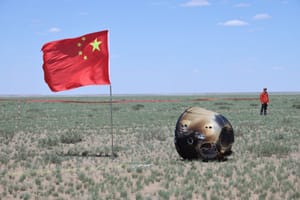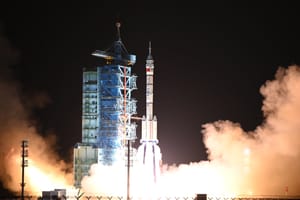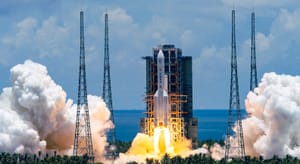
Jun 25, 2024
Lunar far-side samples brought to Earth by Chang'e 6!
China's Chang'e 6 probe departed for the Moon's far side a little over fifty-three days ago, it would later land on the Moon at the start of June. Today, the Chang'e 6 probes re-entry capsule touched down at the landing site located in Siziwang Banner, inside the Inner Mongolia Autonomous Region in northern China.
Chang'e 6's re-entry capsule entered the atmosphere at 13:41 pm China Standard Time, or 05:41 am Universal Coordinated Time, with it touching down under a parachute a little over 20 minutes later at 14:07 pm, or 06:07 am.
After the soft landing teams secured the re-entry capsule for transportation. The samples will be kept inside a vacuum canister, inside the capsule, until they are distributed from the Chinese Academy of Sciences in Beijing, to ensure they remain in as similar conditions to the Moon as possible.

This mission is the first to retrieve lunar samples from the far side of the Moon and bring them back to Earth for study. It was also the second time China landed a spacecraft on the far side of the Moon, as it landed Chang'e 4 back in January 2019 where it is still believed to be operating today.
China's space and scientific agencies expect the Chang'e 6 mission to have brought back a little under 2,000 grams of samples.

The lunar samples brought back by Chang'e 6 are from the Apollo basin's rim in the South Pole-Aitken basin, as researchers hope to understand the differences between the composition, terrain, and lunar crust thickness of each side of the Moon. Shared by the Global Times, Yue Zongyu, a Researcher at the Institute of Geology and Geophysics Chinese Academy of Sciences, said the following about what researchers hope to discover:
"Chang'e 6 has obtained samples from the far side of the moon for the first time, which is expected to reveal one of the most fundamental scientific questions in lunar science research: what causes the differences between the two sides of the moon?" – “What I most hope for is that the samples brought back by Chang'e 6 contain some impact melt materials from the Apollo impact craters and the South Pole-Aitken basin, which can provide crucial clues for studying the early impact flux on the moon."
Yue added that the far-side samples could also significantly help us understand the early history of the Moon and solar system. As part of their return coverage, CGTN spoke to Yang Wei, another Researcher at the Institute of Geology and Geophysics Chinese Academy of Sciences, who said the following about the significance of the mission:
"The Chang'e 6 mission represents a significant milestone in the history of human lunar exploration, and it will contribute to a more comprehensive understanding of lunar evolution, " – "New samples will inevitably lead to new discoveries."
Based on the lunar geological characteristics of the sample location they are expected to consist of lunar volcanic rock that is approximately 2.5 million years old, the Apollo basin is thought to be formed from an impact over 4 billion years ago. More information about the Chang'e 6 landing and sample site, along with what materials it contains, can be found here.
This was the second lunar sample return mission performed by China, with the previous one being Chang'e 5 in late 2020. Chang'e 5's lunar samples led to the discovery of Changesite-(Y), which may have potential uses for nuclear fusion due to it containing Helium-3.
Journey of Chang'e 6
Chang'e 6's lunar voyage began on May 3rd when it was carried skyward by the Long March 5 rocket from the Wenchang Space Launch Site. The Long March 5 performed perfectly for the launch to send Chang'e 6 toward the Moon.
Lunar operations began on May 8th when the spacecraft performed a braking burn to enter lunar orbit. The lander remained attached to the orbiter for three weeks in Lunar orbit before it began landing preparations.
After almost two days flying alone, the Chang'e 6 lander touched down on the southern side of the Apollo Basin, at 41.6385°S 153.9852°W. Surface and sampling operations lasted almost forty-nine hours, as a drill and scoop were used to retrieve a variety of samples.

Once the samples were secured inside a canister on the ascent module it blasted off from the lunar far side on June 4th. The ascent module would spend two days approaching the Chang'e 6 orbiter before docking on June 6th. After docking the sample canister was transferred into the re-entry capsule, once the canister was confirmed to be secure the ascent module was undocked ahead of the return to Earth.
On June 21st the Chang'e 6 orbiter performed its Earth-bound burn to leave lunar orbit, beginning the four-day journey home. A few hours before atmospheric entry the re-entry capsule was separated from the orbiter, this allowed the capsule to enter the atmosphere and give the orbiter enough time to perform a burn to avoid burning up.
Finally, on June 25th the re-entry capsule touched down in China's Inner Mongolia Autonomous Region, engine the almost fifty-three day mission.
What's next for China's lunar exploration?
Chang'e 7 is targeting launch in 2026 for a lunar landing on the southeastern ridge of the Shackleton crater near the lunar south pole. At Shackleton crater the spacecraft will survey the south pole's environment and search for potential water ice.
Chang'e 8 is targeting launch in 2028 for a landing near the lunar south pole, the specific landing location is still being decided. The mission will be similar to Chang'e 7 but it will also test in-situ resource utilization ahead of long-term human stays on the surface.
China is also planning to land at least two people on the surface of the Moon, and return them to Earth, as part of a short-duration mission before 2030. This will be enabled by their in-development Mengzhou crew spacecraft and Lanyue lunar lander, both will launch on their own Long March 10's and meet in lunar orbit.



